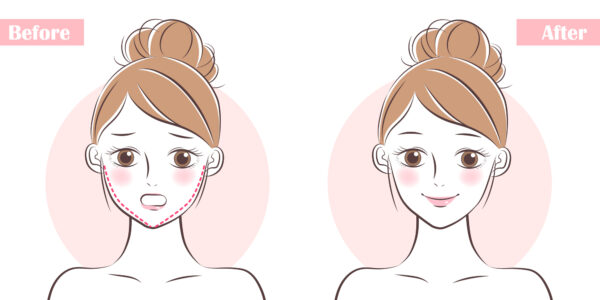
Botox is highly effective in treating temporomandibular joint disorders (TMJ) and reducing teeth grinding and clenching.
It’s true that everyone seems to be striving for a snipped, glass-like jawline. The jawline frequently loses its distinct definition as the face ages naturally. Although injectables are frequently used to reduce wrinkles and smooth out fine lines, Botox can also be used for mind-blowing results.
A smooth, tight jawline can be achieved with a few well-placed Botox injections, sometimes in conjunction with other aesthetic procedures. Many injectors think Botox is the ideal treatment for reducing teeth grinding and clenching, as well as for easing symptoms of temporomandibular joint disorders (TMJ), in addition to its anti-wrinkle applications. Here is all the information you need on administering Botox to slim the face and relax the jaw muscles.
Botox’s Positive Effects on the Jaw
Botox injections into the masseter (or jaw) muscles can relieve TMJ symptoms, make the jawline look slimmer, and reduce teeth grinding and clenching. The masseter muscles, which run along the sides of your lower jaw posteriorly, are the ones Botox is most effective on.
But if you don’t get it fixed, your jaw can start to square up, and you’ll be in a lot of discomfort. Hypertrophy of the face muscles, dental decay, jaw pain and stiffness, disturbed sleep, and other complications can all develop over time.
Botox injections in the jaw area are helpful for treating TMJ disorder and easing stress-related jaw strain. Pain, stiffness, and difficulty opening and closing the mouth are all symptoms of the temporomandibular joint disorder (TMJ), a pathological condition affecting the jaw joint and the muscles that control jaw movement.
A few quick injections of Botox are a painless alternative to bulky bite plates and other irritating dental tools for weakening the masseter muscles and improving TMJ.
How Botox makes the Jawline thinner

Botox injections in the jaw area can help you obtain a thinner lower face.
A slimmer lower face can be achieved using Botox injections in the jaw area. Facial volume, collagen and elastin production, and the density and resorption of face bones all decrease with age, which leads to a loss of skin firmness and elasticity.
As a result of these alterations, the jawline and jowls become less defined due to drooping and tissue laxity. In order to achieve a softer, more feminine appearance while also slimming the lower face and regulating facial proportions, Botox can be used to relax the muscles around the rear of the jawline. Instead, the face can take on a more feminine heart or oval form than a masculine square or rectangle.
There’s no denying the dramatic effects of a few Botox injections on the lower third of the face and the face as a whole, but reducing the size of your jaw with Botox won’t reverse the effects of time on your jaw.
Who’s qualified?
Jawline Botox injections can help people with enlarged masseter muscles reduce jaw clenching, grinding, and TMJ symptoms. Prospective patients by having them clench their jaw, which shows the masseter muscle. Muscle bulges indicate treatment eligibility.
Although Botox injections into the jaw have many benefits, they may actually make the jawline look worse in people who already have excessive laxity or drooping in the jowl area due to the natural aging process. By relaxing the jaw muscles, one can move facial tissues away from the jowls. That’s why it’s important to carefully choose patients and assess them before beginning treatment.
How does someone administer Botox to the jaw?
Before they mark the injection sites by outlining the muscle with a white chalk pencil, your injector or dermatologist will examine and clean the area. As everyone’s muscle growth is different, there is no recommended dosage for treating the jawline. However, to achieve the required relaxing effect, typically 20 units of a neuromodulator are injected into each masseter muscle.
Injections of Botox into the jaw feel like tiny, barely perceptible pinpricks. It is possible to use topical anesthetics beforehand, but this is rarely necessary. The process moves quickly with little downtime.
Treatment by a trained expert familiar with facial anatomy is recommended to reduce the likelihood of negative reactions. A lowered grin may result from an incorrect injection into the masseter muscle. However, if the injection is administered too superficially, the masseter will appear enlarged.
The effects of Botox can be seen anywhere from three to 10 days after the injections are made. You’ll gradually start to feel less stress on the lower jaw if you’re receiving treatment to improve clenching symptoms. However, the benefits only last for a few months before more treatments are necessary. This is similar to how Botox for aesthetic purposes works. Dentox can show you how to provide your patients with the best possible outcomes when injecting Botox into their chins and jaws. This may encourage patients to return for additional aesthetic treatments. Dr. Howard Katz, one of the best injectables instructors in the country, gives his students the chance to study with him in person, online, or at their own convenience. Dentox can provide you with top-notch education so that you can provide the greatest care for your patients and increase your business’s profits. Visit https://dentox.com/live-courses/ and https://dentox.com/botox-training/ for details on upcoming in-person and online patient training programs, as well as registration links.







